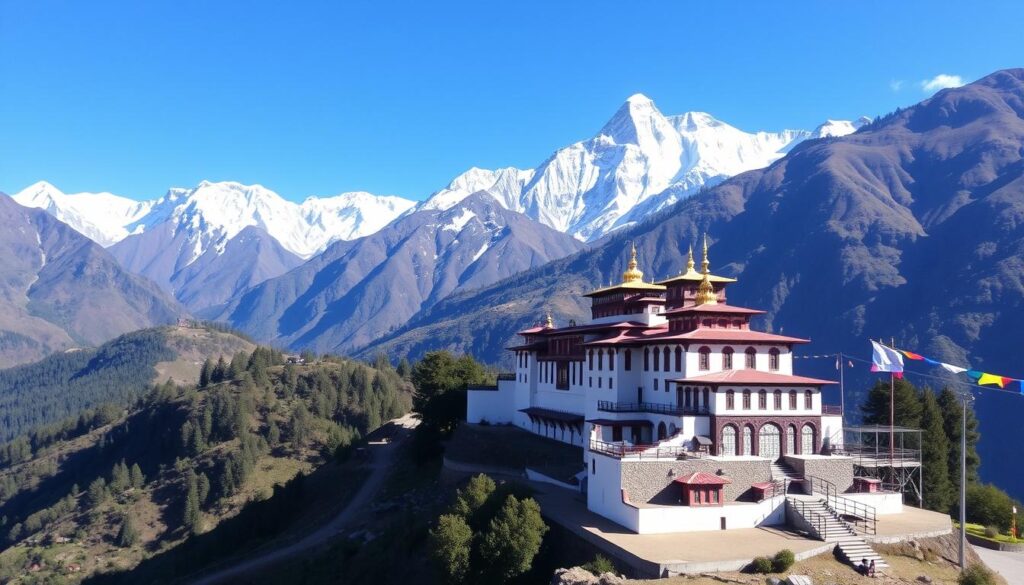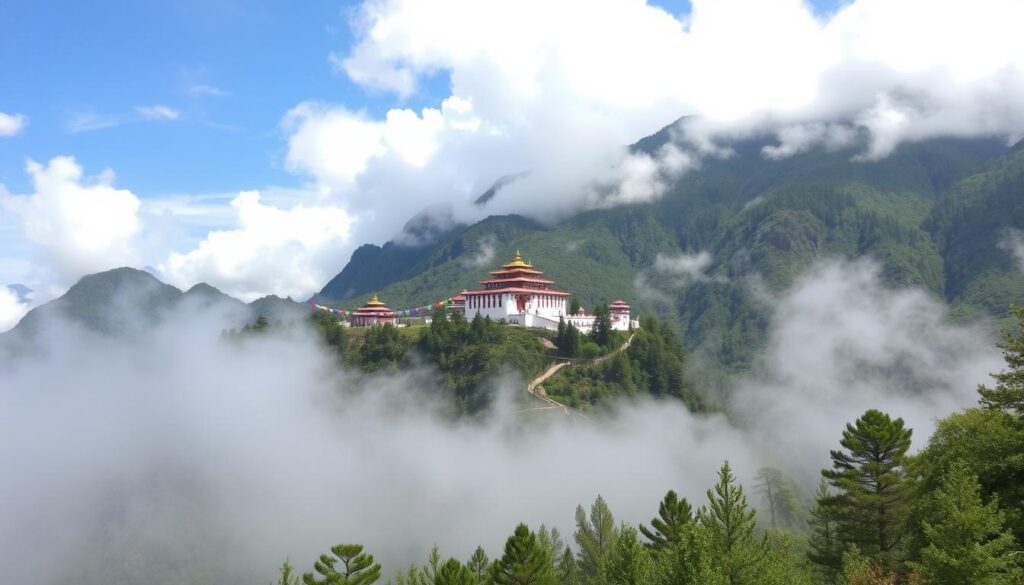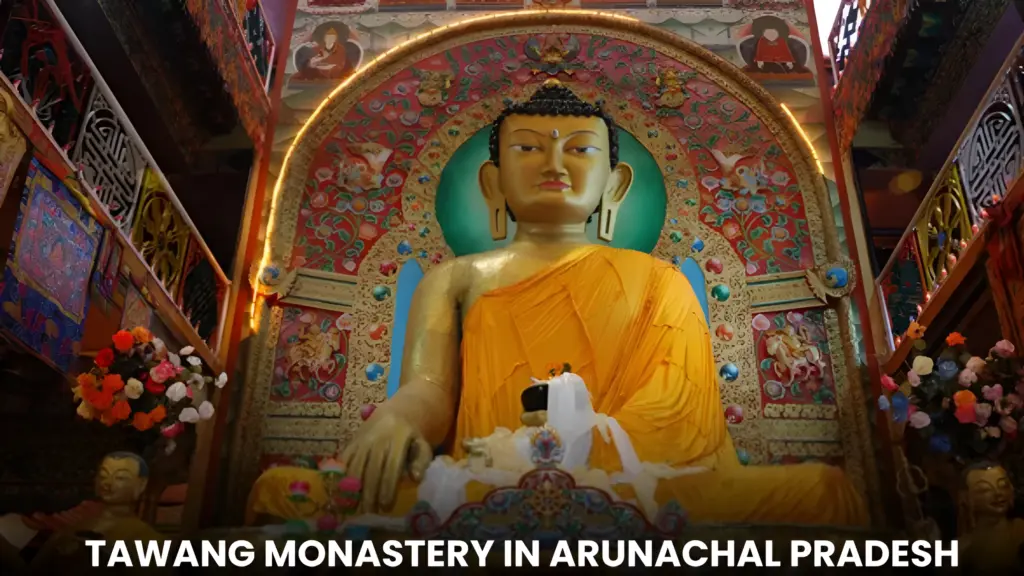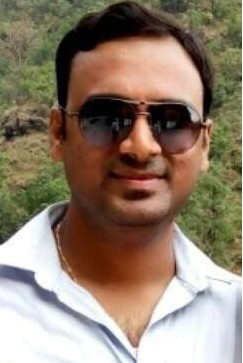Tawang Monastery is the second-largest monastery globally and the largest in India. It’s a top spot for those keen on tawang monastery travel. Nestled in the Tawang Chu valley, it boasts a stunning view of the landscape. Visiting here lets you dive into the rich history and culture of Buddhism.

Exploring tawang monastery is a mix of spiritual and visual delights. Its architecture and artwork highlight its role as a key Buddhist learning and practice center. Whether you’re into history, culture, or spirituality, tawang monastery travel has something for everyone. It’s a perfect place to visit tawang monastery and discover its many wonders.
The Majestic History of Tawang Monastery
Tawang Monastery is in the beautiful town of Tawang in Arunachal Pradesh. It was founded by Merak Lama Lodre Gyatso in 1680-1681. This monastery shows the area’s deep Buddhist roots.
The tawang monastery history is tied to the 5th Dalai Lama, Ngawang Lobsang Gyatso. He was key in starting it.
The monastery’s tawang monastery significance goes beyond its looks. It has about 450 monks and is a major place for Buddhist studies. It’s India’s biggest monastery and the second-largest globally, covering over 140,000 square feet.
Origins and Establishment
The monastery started in the 17th century. Merak Lama Lodre Gyatso built it, following the 5th Dalai Lama’s wishes. This was the start of Tawang Monastery’s important role in Buddhism.
Religious Significance
Tawang Monastery is a holy place for Buddhists. It draws many with its stunning looks and deep spiritual meaning. The monastery’s tawang monastery significance shines in its design, lively festivals, and rich culture.
Architectural Marvel
The monastery’s design is amazing, with 65 homes and a three-story building. The tawang monastery history is seen in its architecture. It’s a top spot for those who love history and spirituality.
Best Time to Plan Your Tawang Monastery Travel
When planning a tawang monastery tour, picking the right time is key. Summer, from March to June, is perfect with mild weather. Temperatures range from -3°C to 21°C, ideal for exploring.
Visiting during the Losar festival adds a special touch. It’s a major event in the Buddhist calendar.
From July to September, the weather is a bit warmer. Temperatures are between 9°C to 22°C. Winter, from October to February, gets quite cold, with temperatures from -11°C to 15°C.
If you love snow, December to February is the best time. The area is covered in snow then.
Before your tawang monastery tour, prepare for the weather and road conditions. The journey to places like Gorichen Peak and Bumla Pass is long. With good planning, your trip will be unforgettable.
Getting to Tawang Monastery: Transportation Guide
To get to Tawang Monastery, you can fly to Tezpur Airport, the closest airport. Or, you can go to Bhalukpong, the nearest train station. From there, a taxi or bus will take you to the monastery.
The trip from Guwahati to Tawang is about 543 kilometers. It takes around 14-16 hours by road. You can stop at Tezpur, Bhalukpong, Bomdila, or Dirang for a scenic break.
For a Tawang Monastery tour, know that a helicopter service runs from Guwahati to Tawang. The road trip from Guwahati to Tawang Valley takes about 20 hours. But, with better roads, travel times are getting shorter.
Visiting Tawang Monastery by air or road is breathtaking. The valley’s beauty and the monastery’s architecture will amaze you.
By Air
There are direct flights from New Delhi and Kolkata to Guwahati every day. Flights from Mumbai, Chennai, Bangalore, Hyderabad, and Jaipur also operate with a single stop. Airlines like Air India, Indigo, Jet Airlines, Spice Jet, and Go Air offer these flights.
By Road
The bus fare from Guwahati to Tawang is about Rs. 1500 per person. The journey from Bhalukpong to Tawang includes stops for picking up passengers and goods. The distance from Tezpur to Tawang is 330 km, taking 10 to 12 hours to travel.
Local Transport Options
Once in Tawang, you can use local transport to see the valley and monastery. Tawang Valley is at 10,000 feet above sea level. It’s best to spend at least 5 days here, with extra days for nearby attractions.
Essential Travel Permits and Documentation
Before you start your tawang monastery travel, knowing the travel permits and documents needed is key. To explore tawang monastery, you must get an Inner Line Permit (ILP). This can be done in Guwahati or other places set by the authorities. The cost of the ILP varies from ₹100 to ₹500, depending on how long you plan to stay.
The online ILP application takes 24-48 hours. Offline, it takes 3-5 working days. It’s wise to apply 7-10 days before your trip to avoid any trouble. The ILP is valid for a short time, from a few days to a month, depending on your visit’s purpose.
Foreign tourists also need a Protected Area Permit (PAP), which costs about $50. Getting a PAP can take up to a week. To avoid delays, start applying early.
Knowing about the necessary permits and documents helps make your tawang monastery travel smooth and fun. Always explore tawang monastery with care and respect for the local culture and environment.
Accommodation Options Near Tawang Monastery
Planning a trip to Tawang Monastery means looking at different places to stay. Tawang has many options, from fancy hotels to simple guesthouses and homestays. It’s important to pick a place that fits your needs and makes your stay comfortable.
For those who want luxury, Tawang has high-end hotels with lots of amenities. There are also mid-range and budget hotels for those on a tighter budget. Guesthouses and homestays offer a chance to really get to know the local culture.
Government accommodations are another choice, spread out in various areas. With so many options, visitors can enjoy their time at the monastery without stress. The right place to stay can make your trip to Tawang Monastery even better.
Luxury Hotels
Luxury hotels in Tawang offer great amenities and services for a comfortable stay. They are perfect for those looking for a top-notch experience.
Budget Guesthouses
Budget guesthouses and homestays are affordable and offer a real taste of local life. They are great for travelers on a budget or anyone wanting a unique stay.
Homestay Experiences
Homestays in Tawang let you dive into the local culture, offering a memorable experience. Staying with a local family, you can learn about their traditions and make lasting connections.
Inside the Monastery Complex
When you visit Tawang Monastery, you’ll see a mix of Tibetan and Indian designs. The monastery’s importance is clear in its large structures. The Dukhang, a three-storied hall, stands out with a huge Buddha statue about 25 feet tall.
The Dukhang is the biggest building in the monastery. It shows the rich culture and faith of the area.
The monastery has a library with old scriptures and homes for the monks. It has 65 buildings and a 925 feet long wall. Walking through, you’ll see the monastery’s importance and the need to keep its traditions alive.
Visiting the Tawang Manuscript Conservation Centre is a must. It has over 200 manuscripts, with 31 being preserved. The monastery oversees 17 gompas and owns land in nearby villages. Exploring Tawang Monastery lets you understand its history, architecture, and cultural value. It’s a rewarding experience.
Sacred Artifacts and Collections
The Tawang Monastery is filled with sacred artifacts of great cultural and religious value. These items show the monastery’s rich history and its key role in Tibetan Buddhism. The collection includes ancient scriptures, thangka paintings, and Buddhist artifacts, cherished by many.
The monastery’s library has over 1000 valuable manuscripts, prints, and digital collections. These cover religion, philosophy, art, history, culture, Tibetan medicine, science, and technology. The Kangyur and Tengyur, key texts in Tibetan Buddhism, are part of the collection. They highlight the monastery’s role in preserving Buddhist culture and its significance.
The artifacts and collections in the Tawang Monastery are crucial to its history and Tibetan Buddhism. The monastery’s collection is a treasure of Buddhist culture and history. It offers insights into Buddhism’s teachings and the lives of monks in the monastery.
Visitors to the Tawang Monastery can explore its vast collection of sacred artifacts. They can gain a deeper understanding of the monastery’s history and significance. The artifacts and collections show the lasting legacy of Tibetan Buddhism and the importance of preserving cultural heritage.
Participating in Monastery Activities
For a deeper experience, join in the monastery’s daily activities during your tawang monastery travel. Attend early morning prayers, watch monks dance, or talk to them. This will enrich your tawang monastery tour and help you understand the monastery’s importance.
Visitors can connect with the monks and learn about their traditions. This way, you’ll appreciate the monastery’s rich cultural heritage. The monastery’s daily life adds to its charm, making your visit unforgettable.
Whether you’re into history, culture, or spirituality, monastery activities offer a unique experience. Plan your tawang monastery travel to include these activities. Tawang offers stunning landscapes, vibrant culture, and historical significance for all travelers.
Local Customs and Etiquette
When you visit Tawang Monastery, it’s key to respect local customs and etiquette. This makes your visit better and more meaningful. Dress modestly and remove your shoes before entering the prayer hall. This shows respect for the monastery and its traditions.
Visit from March to October for the best experience. This time offers great weather and fewer crowds.
As you explore, you’ll want to take photos. But remember, some areas are off-limits. Photography is okay in most places, but not in the main prayer hall. Being mindful of these rules helps keep the monastery peaceful.
Respecting local customs makes your visit better. Whether you’re here to visit or explore, being considerate is important.
Dress Code
The dress code at Tawang Monastery is modest. It shows respect for the monastery and its people. Dressing right makes your visit more positive and meaningful.

Photography Rules
Photography is allowed in most areas. But, some places are off-limits. Knowing and following these rules helps keep the monastery peaceful.
This way, you can enjoy your visit more. Whether you’re here to visit or explore, it’s good to be respectful.
Behavioral Guidelines
Be respectful and considerate as you explore. Remove your shoes before entering the prayer hall. And don’t take pictures in restricted areas.
Following these simple rules makes your visit better. It ensures a positive experience for everyone, making the most of your time at Tawang Monastery.
Nearby Attractions and Side Trips
Tawang Monastery is a big draw, but there’s more to see around it. For a full tawang monastery tour, check out the Tawang War Memorial. It honors Indian soldiers from the 1962 Indo-China War. It’s just 1 km from Tawang and perfect for history buffs.
Don’t miss Shonga-tser Lake, 36 km from Tawang. It’s a beautiful spot with mountains and forests. Nuranang Falls, near the road to Bomdila, is another must-see. It’s a 100-meter drop into a stunning scene.
For trekking fans, Gorichen Peak is a must-visit. It’s the highest in Arunachal Pradesh, drawing many adventurers. Tawang’s history, nature, and culture make it a standout travel spot.
Tawang offers history, nature, and culture for all interests. With great tawang monastery travel plans, you’ll see the best of Tawang. So, plan your tawang monastery tour now and make memories in this beautiful place.
Embracing the Spirit of Tawang: A Transformative Journey
As you leave the Tawang Monastery, its lasting impact stays with you. This place, filled with over 400 years of history, connects you deeply to Buddhism and the area’s rich culture. The Tawang Monastery‘s golden statues and the Tawang Valley‘s calm beauty show the perfect mix of spirituality and nature.
The tawang monastery significance goes beyond its stunning buildings. It’s a light of wisdom, guiding travelers on a tawang monastery travel path of self-discovery. Dive into the rituals, talk with the monks, and feel the peace. It helps you find calm and a new direction in life.
When you leave Tawang, you carry with you valuable lessons, cherished memories, and the drive to explore more of Arunachal Pradesh. This journey changes your view and encourages you to embrace Tawang’s spirit. Here, old traditions and new wonders live together in perfect balance.
FAQ
Q: What makes Tawang Monastery a must-visit destination?
A: Tawang Monastery is famous for its rich Buddhist culture and history. It offers a unique chance to see its beautiful architecture and learn about Buddhism. It’s also a key place in the Buddhist world.
Q: When is the best time to visit Tawang Monastery?
A: The best time to visit Tawang Monastery depends on the weather and festivals. Plan your trip for the monastery’s big events and the best weather.
Q: How can I reach Tawang Monastery?
A: You can get to Tawang Monastery by air, road, or local transport. The article gives details on airports, railheads, and how to get to the monastery. It makes planning your trip easier.
Q: What travel permits and documentation are required to visit Tawang Monastery?
A: To visit Tawang Monastery, you need travel permits and documents like the Inner Line Permit. The article explains how to get these, so you’re ready for your trip.
Q: What are the accommodation options near Tawang Monastery?
A: There are many places to stay near Tawang Monastery. You can choose from luxury hotels, budget guesthouses, or homestays. This lets you pick what fits your budget and preferences.
Q: What can I expect to see and experience inside the Tawang Monastery complex?
A: Inside the Tawang Monastery complex, you’ll see amazing structures like the Dukhang and the library. You can also see the monks’ living quarters. It’s a chance to see unique architecture and learn about history.
Q: What are the sacred artifacts and collections housed within Tawang Monastery?
A: Tawang Monastery has a collection of sacred items. These include ancient scriptures, thangka paintings, and other important Buddhist artifacts. They show the monastery’s rich culture and history.
Q: How can I participate in the daily activities of Tawang Monastery?
A: You can join in the monastery’s daily life. Attend morning prayers, watch monk dances, and talk to the monks. It’s a great way to learn about their practices and way of life.
Q: What are the local customs and etiquette I should be aware of when visiting Tawang Monastery?
A: It’s important to respect local customs and etiquette at Tawang Monastery. The article gives tips on dress code, photography, and behavior. This way, you can enjoy your visit while respecting the monastery’s traditions and culture.
Q: What other nearby attractions can I visit during my trip to Tawang Monastery?
A: Tawang Monastery is a big attraction, but there’s more to see nearby. You can visit natural spots like lakes and waterfalls, and historical sites like the Tawang War Memorial. It’s a great way to see more of the area.


